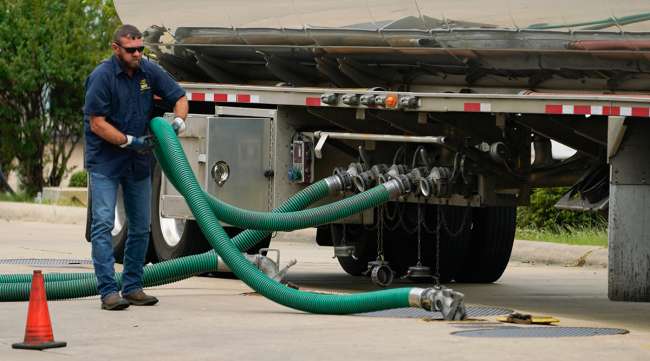Regional Variance Produces Tiny Drop in Diesel’s National Average

[Stay on top of transportation news: Get TTNews in your inbox.]
The national average price of diesel dropped for the ninth consecutive week, but by just two-tenths of a cent.
The Energy Information Administration said in its weekly update Aug. 22 that diesel declined to $4.909 a gallon nationally. It now costs $1.585 more than it did a year ago. The national average for a gallon of gasoline slid 5.8 cents to $3.88, still 73.5 cents a gallon more than a year ago.
The average price of diesel rose by 1.8 cents a gallon in the Midwest, joining the Gulf Coast, the West Coast, the West Coast less California, and California as regions where the price increased. It fell by a hefty 8.2 cents a gallon in the Central Atlantic, joining the East Coast, New England, the Lower Atlantic and Rocky Mountains as regions where the price dropped. It’s cheapest in the Gulf Coast at $4.619 a gallon, and most expensive in California at $6.029 a gallon.
U.S. average on-highway #diesel fuel price on August 22, 2022 was $4.909/gal, DOWN 0.2¢/gallon from 8/15/22, UP $1.585/gallon from year ago #truckers #shippers #fuelprices https://t.co/hZzaMfaTzS pic.twitter.com/okHNx4ey78 — EIA (@EIAgov) August 23, 2022
“Obviously the downward trend in the price of diesel is positive,” said Heather Dohrn, chief commercial officer at Dohrn Transfer Co. “The impact on the cost of fuel on LTL carriers varies based on the territory that they cover.”
Dohrn Transfer is a Midwestern carrier based in Rock Island, Ill. The carrier provides truckload, less-than-truckload, warehousing and other transportation services. The majority of the area that it covers is rural. The lack of density means that its drivers average many miles between stops.
“As a result, fuel is a higher percent of our cost per shipment than carriers who operate in metropolitan areas,” Dohrn said. “When the fuel prices increase, it has more of an impact on us. We have been able to offset that cost somewhat with fuel surcharges, but it is certainly good news to see the downward trend released by the EIA.”
Diesel prices started rising last year after a period of low costs brought on by the coronavirus pandemic. The increase accelerated earlier this year due to a variety of economic and geopolitical factors. The American Transportation Research Institute found that the cost of diesel was the most significant contributor to record trucking operational costs last year.
“The broad outline of these findings that costs were going up was not terribly surprising,” said Alex Leslie, research analyst at ATRI. “But in a year where costs were going up so much and across the board, that makes it all the more important to have a good sense of precise numbers. How much are they going up becomes really important in a year like 2021 where there was so much uncertainty.”
The ATRI Analysis of the Operational Costs of Trucking report Aug. 10 found that average marginal operating costs per mile jumped 12.7% year-over-year to $1.855 per mile in 2021. Fuel was the single-largest driver of this change, having grown 35.4% year-over-year to 41.7 cents per mile. Repair and maintenance, as well as driver wages, were also leading contributors.
U.S. average price for regular-grade #gasoline on August 22, 2022 was $3.880/gal, DOWN 5.8¢/gallon from 8/15/22, UP 73.5 cents/gallon from year ago #gasprices https://t.co/O4abrAdDdv pic.twitter.com/RZpmfuvh4n — EIA (@EIAgov) August 23, 2022
“We saw fuel costs really drop down and that really was one of the major factors for 2020,” Leslie said. “Low fuel costs helped offset rising costs in other cost centers. The huge jump up in percentage by 35.4% to 41.7 cents per mile, part of that was simply offsetting a lower than usual year.”
Leslie pointed out that the problem isn’t just how expensive fuel became but also how quickly that happened. When spikes in prices are sudden, carriers are more likely to get hit because their fuel surcharges don’t adjust quickly enough.
“The suddenness is one factor that makes a big difference,” Leslie said. “It is tough to tell what the year will look like overall or what the start of 2023 will look like. The U.S. Energy Information Administration has some cautious optimism about prices continuing to come down, but the confidence intervals on their models are pretty wide. So, I think at this point it’s still a bit up in the air as to what that trend is going to look like leading into next year.”
The report did point to some optimistic news, despite the rising operational costs, in that carriers are getting more efficient. The carriers in the study emphasized greater efficiency having been faced with challenges throughout the supply chain. That includes empty mileage decreasing to 14.8% and average truck fuel economy increasing to 6.65 miles per gallon.
On-Highway Diesel Fuel Prices

EIA.gov
Want more news? Listen to today's daily briefing below or go here for more info:




